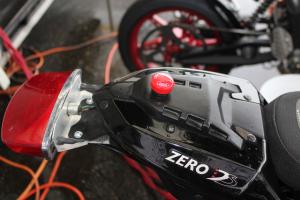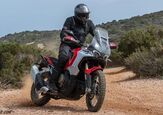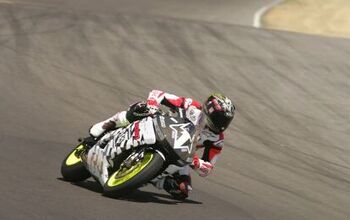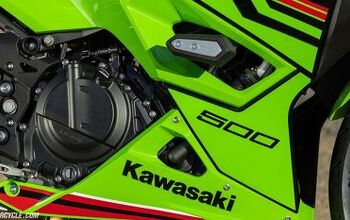Racing Electric Motorcycles - Video
Hang around this sport long enough and you’ll likely hear the adage, “It’s more fun to ride a slow bike fast than to ride a fast bike slow.” It’s something I already believe, but after racing a 2012 Zero S in the second round of the TTXGP series at Portland International Raceway, I was reminded once again how true this statement is.
If you’re an astute Motorcycle.com follower, you’ll remember our Recharging TTXGP story, where we caught up with Azhar Hussain of TTXGP during the first round of the North American series at Infineon Raceway. As part of an effort to expand the grid sizes for each event, a new class dubbed “E-Superstock” was introduced with the help of Kenyon Kluge of Zero Motorcycles.
Kluge, a former AMA competitor, now Director of Electrical Engineering at Zero, had the idea to race production e-bikes – models currently for sale in dealerships – much like they do with gas-powered production motorcycles. Hussain liked the idea, and thus E-Superstock was born, with the class debuting at Infineon. We caught up with Kluge at Sonoma, and I half-jokingly offered my services should he need a rider for one of the four Zero S racebikes he brings to every event – the same four bikes that currently make up the class at the moment.
Not expecting much to come of my offer, two weeks before the second round of the series at Portland International Raceway, Kluge, in mild desperation, decided to call my bluff. “Do you want to ride one of the bikes? My original riders can’t make it.” Not one to pass on a golden opportunity, I accepted.
Meant as an alternative to the high-dollar one-off machines currently racing in TTXGP’s open class, E-Superstock modifications are minimal: strip the mirrors, disconnect the headlight, slap on some sticky rubber, mount a secondary kill switch on the tail per TTXGP rules, and go racing! Granted, the field currently only includes Zero S models, but the point is to get more production e-bikes, regardless of manufacturer, onto the grid.
Having ridden the 2012 Zero DS recently, I came away impressed by its potential. Its performance was no longer toy-like and could finally start being compared to small-displacement gas bikes. To me, the DS (and similar S by extension) marks electric motorcycling’s legitimacy to the masses. And after my time with the DS, I immediately wondered what it would be like on a racetrack with proper rubber. I would soon find out.
“We don’t need no stinkin’ rain tires!”
Being born, raised and based in the wonderful climate that is Southern California, the term “June gloom” never had much meaning to me. I packed light and brought perforated leathers, preparing for a warm weekend. Of course upon landing in Portland the skies were grey with a high probability of rain throughout the weekend. D’oh!
I arrive at the track to be greeted by Kluge who then introduces me to our support crew of Gabe DeVault and Luke Workman, fellow Zero cohorts by day who like to tinker and support Kluge’s racing efforts in their spare time. Piloting the other two racebikes are local OMRRA racers Don Headrick, a former Heavyweight Twins champion on various Ducatis, and Chris Page, the defending Ninja 250 class champion. Between the four of us, all had won club racing championships, setting the stage for what promised to be a thrilling race.
The weekend’s schedule had one practice session Saturday morning, followed by qualifying in the afternoon. Sunday featured practice in the morning, then the race. Since neither Kluge nor I had ridden this track before, we knew we would have to utilize as much track time as possible to learn where to go if we were to stand a chance against our fellow race-mates. With the rain coming down before the start of our first practice session, Headrick and Page decide to sit out, while Kluge drops a bombshell: “I don’t have rain tires or the budget to buy them. Are you fine running these Pirelli Supercorsas the whole weekend?”
“No problem,” I said, wanting to be a team player while secretly wishing for rain tires. “As long as we’re all on the same equipment, it’ll be an even race.” The others agreed and the two of us tip-toed around the track for our first practice session, mostly trying to avoid falling more than anything else.
Despite my immediate attention focusing on the track, it’s impossible not to notice the silence surrounding me while doing so. Instead of being greeted with the sounds of intake trumpets inhaling air and exhaust pipes spitting it out whenever I twist the throttle, on the Zero the only noise is the wind as man and machine slice through it.
And because it uses a single-speed transmission, there’s no clutch lever or shifter to worry about either. It truly is “twist-n-go” racing. By design, throttle application feels very similar to a traditional motorcycle. With its dirtbike-like styling, the Zero S feels much like a supermoto machine while riding.
Thankfully Portland International Raceway is an easy track to learn. With only nine turns, seven of which are rights, the 1.9-mile track feels like a giant oval on the Zero. The team experimented with gearing during the practice session, with my bike equipped with shorter gearing than Kenyon’s.
We struggled to decide whether to optimize the bikes for drive off each corner or top speed (and the draft) on the 7/8-mile front straight. Ultimately, with my bike reaching its top speed (roughly 90 mph) quickly on the front straight, the decision was made for taller gearing and all four bikes were equipped equally.
To gain extra track time, Kluge and I entered our Zero race bikes in the Ninja 250 race on Saturday. The rain had stopped, the sun started to shine and the track was showing a dry line. But as I prepared to leave the pits, my Zero refused to go anywhere and I missed the race. The team traced the issue to water in the circuit board causing a short. With the help of some compressed air, we dried the circuit board and all was good again.
Now I know what you’re thinking. “Will all Zeros short like this if I ride in the wet?” No, they will not. Kluge, DeVault and Workman all assured me production models all have completely sealed systems and are absolutely safe to ride in the rain.
The four Zero S racebikes we rode are all pre-production models used by the research and development arm of Zero, each containing at least 10,000 miles of testing on the odometer. Meaning they have gone through numerous testing stages, teardowns and rebuilds to collect data. In the end, my bike wasn’t put together like a standard Zero S coming off the assembly line and is not representative of the build quality the standard bike receives.
Qualifying
Having missed my chance to ride during the Ninja 250 race, my first shot at seeing the dry racetrack was during TTXGP qualifying. With limited track time under my belt, the plan was to shadow Page’s every move. We are of similar build, and his track knowledge aboard small-displacement motorcycles meant he knew the best lines for carrying momentum.
Before venturing out, however, DeVault warned us to keep an eye on the temperature light, as we’d be riding at full throttle for much of the 20-minute session. “If it’s blinking, you’re reaching the motor’s thermal limit — which is good, since it means the motor’s working at maximum efficiency. If it stays solid, it means you’ve reached the thermal limit and power will decrease very slightly to avoid overheating.”
Obviously as racers we always want full power. “Don’t worry,” he said, “If it happens, the drop is so subtle I doubt you’ll even notice.” “Right,” I thought, in slight disbelief. Not three corners in to the session, caution over conserving power was thrown to the wind and the four of us were stuck to each other. This continued for the entire session with all four riders taking turns at the front of the pack.
About 15 minutes into the session, I noticed the temperature light went from blinking to solid. And while I did notice a very minor drop in power, it appeared as though the others had experienced it too. With all of us seemingly on a level playing field, I ignored the light and latched on to Page for the remainder of the session. At least I tried to anyway.
Page had used his track knowledge to run away from the rest of us, setting a 1:40.593 lap time to qualify on pole for the E-Superstock class and fourth overall. I qualified third in class with a 1:41.040. To put this in perspective, Page’s fastest Ninja 250 time of the weekend was a 1:26.831. While a big difference, Page felt, with more top end power, the Zeros could easily contend with the Ninja. Corner speeds were similar, but the Kawasaki would pull away on the long straights.
Chris Ancien, on the Motoczysz E1PC clocked a 1:15.839 to lead all TTXGP qualifiers. After setting his fast lap time, however, Ancien’s machine developed a severe overheating issue, causing one of the batteries to burn. The burn was contained, but Michael Czysz, team owner, namesake and second rider, decided to withdraw his entries from the race.
This slotted defending TTXGP champ and third-place qualifier, Steve Atlas, aboard his Team Icon Brammo Empulse, to pole position overall, logging a 1:18.949, three seconds slower than the E1PC. Matt Kent (1:34.494) was next, riding a converted 2006 Honda CBR600RR for the student-run Virginia Tech Bolt team, and the ProtoMoto entry of Ely Schless (1:37.441), aboard his converted 1994 Honda RS250, was now third. The four Zero machines filled the rest of the grid.
Interestingly, the Lightning team, winners of the first round at Infineon, was a no-show. And the Motoczysz entries – the same bikes that won the TT Zero Isle of Man race – had just returned to their Portland base from the Isle of Man less than 24 hours earlier. With no time to prepare, the team loaded their truck and went straight to the track.
Race Day
In qualifying, the importance of the draft came into play. Similar to bicycle racing, whenever someone would pull away, the peloton would use the draft to reel in the leader. With all four riders qualifying within a half second of each other, we knew it would be a tight race.
That said, Page was looking like the odds-on favorite to win the race. Not only did he produce the fastest time of us four, he also maintained consistency. For his part, Headrick’s fast lap was only two-tenths slower than Page’s, but he wasn’t able to maintain that pace for the whole session. My strategy, again, was to ride as hard as I could and latch on to Page, hoping to stay with him and find an opening at the end.
When the green flag dropped, I got the best of my teammates and even out-dragged Ely Schless into the first turn, meaning I was not only leading the class but third overall! Not expecting such a good start, I decided to push early on, hoping to break away. It didn’t work, as Page shadowed my every move.
From here, the remaining eight laps were a blur, as the four of us traded positions several times per lap, often drafting from last to first to last over and over again. We might have been the slowest bikes on track, but this gave us plenty of time to look over and see the fans clearly enjoying the tight racing. I had seen my temperature light come on again, and felt a slight power drop, but I ignored it like before, correctly assuming the other guys were experiencing the same thing.
Page had taken the lead as we crossed the line for our white-flag (last) lap, and no sooner had he done so, when Atlas, the overall leader, whizzed past us. Somewhere amongst our dicing, Atlas had lapped us earlier and when we saw him again, he had taken the checkered flag. Unfortunately, Headrick wasn’t able to cross the line ahead of Atlas, meaning his race was done.
Meanwhile, Page was starting to put his track knowledge to good use and I struggled to keep him in my sights. But Atlas, on his cool-down lap, was still on the racing line waving to the fans as Page caught him in turn four. This disruption allowed Kluge and I to catch up to Page, and I passed for the lead heading onto the back straight. As I looked back, I had a decent gap to the two behind me, but knew I didn’t want to lead out of the last turn, as they would draft right past me across the line.
Sure enough, I led coming out of the final turn. But Page had made up the distance and came around me as predicted. Kluge was still lingering in third. However, Page made his move too soon, allowing me to follow directly behind in his draft, and as it sucked me in I pulled out and drove past him right at the line. I won!
Looking at the timing sheets, I won by just 0.153 second over Page, with Kluge crossing a further two-tenths behind Page. Even more impressive, all four riders clocked times three seconds faster than we did in qualifying! Despite the increased pace, the battery gauge said we only used half a charge.
Aftermath
Racing the Zero S only confirmed my earlier thoughts about the DS model: electric motorcycles are starting to gain legitimacy. I had a barrel of laughs the entire weekend, and the close racing was icing on the cake. While we may have been slower than even a Kawasaki Ninja 250, these are still early days and the performance of the bikes will only get better.
“I’m sure of it,” Kluge says. “[Zero] is not staying stagnant, and someday in the near future we’ll be looking way beyond the [Ninja] 250.”
As far as cost is concerned, it doesn’t get much more inexpensive. The biggest cost is the bike itself at $13,995 for the Zero S with a ZF9 battery pack. Fifty bucks will get you the mandatory, tail-mounted secondary kill switch, and other than tires (which can last numerous race weekends), there aren’t any other expenses.
While not mandatory, the $500 accessory quick charger definitely comes in handy during a race weekend. It may sound like a lot, but it’s a one-time purchase, compared to fuel costs incurred throughout a season. Various gearing options are also available through Zero. Many tracks also have outlets, so recharging the battery between sessions won’t cost you a thing.
When you calculate the savings just in fuel and tires, e-bike racing starts to look more appealing. Then factor the intangibles like immensely close racing and being a pioneer in the sport, and the allure of e-bike racing is exciting.
Ultimately, if you’re interested in a new form of motorcycle racing, and can get over the lack of engine noise associated with it, give a look to E-Superstock racing with TTXGP.
Related Reading
EV Live Oregon Report
2012 Brammo Empulse and Empulse R First Look – Video
Recharging TTXGP – Video
2012 Zero DS Review – Video
The State of Zero in 2012 and Beyond – Video
2012 Zero Electric Motorcycle Lineup Unveiled – Video
All Things Electric Motorcycles on Motorcycle.com
More by Troy Siahaan


























![Worlds Smallest Electric Motorcycle? [video]](https://cdn-fastly.motorcycle.com/media/2023/05/31/11738731/worlds-smallest-electric-motorcycle-video.jpg?size=350x220)

![2012 Zero Electric Motorcycle Lineup Unveiled [Video]](https://cdn-fastly.motorcycle.com/media/2023/05/07/11559124/2012-zero-electric-motorcycle-lineup-unveiled-video.jpg?size=350x220)
![Custom Electric Motorcycle [video]](https://cdn-fastly.motorcycle.com/media/2023/05/31/11737072/custom-electric-motorcycle-video.jpg?size=350x220)













Comments
Join the conversation